After 7 Cyclist Deaths In 2022, Will More Protected Bike Lanes Help?
Milwaukee is seeing an increase in bicyclist and pedestrian injuries and deaths.
Milwaukee officials are hopeful more protected bike lines across the city will make the streets safer and lead to fewer bicycle deaths and injuries.
In Milwaukee County, there were seven bicycle fatalities in 2022, five of those in the city of Milwaukee. Robert Schneider, an urban planning professor at the University of Wisconsin-Milwaukee, called that figure “unexpectedly high.”
“These are concerning trends more broadly, and maybe the reason that we had more bicyclist fatalities in 2022 may relate to that overall declining safety in terms of traffic fatalities in the Milwaukee area,” Schneider said.
City officials have called reckless driving a “crisis” in the community and have taken a number of steps to tackle the problem. To keep bicycle riders safe, Milwaukee Mayor Cavalier Johnson recently announced a new goal of building 50 miles of protected bike lanes by 2026.
“I want the roadways to be safer for all users … whether you’re a pedestrian, whether you’re a scooter rider, whether you’re a stroller pusher, whether you’re a bicyclist,” Johnson said.
Johnson pointed to protected bike lanes added to a portion of Milwaukee’s busy North Avenue on the city’s east side, as well as an $8 million project to remove traffic lanes and place a new bike path on eight blocks of West Walnut Street. Jake Newborn, assistant director of Wisconsin Bike Fed — a nonprofit bike advocacy group — is supportive of the plan. Newborn said traffic-calming efforts and street redesign could also make the roads safer.
“Those are the things that not only make it safer for people riding, but also increase ridership numbers, because people then have a place that they feel a little safer to ride on,” Newborn said.
Traffic deaths a ‘sustained trend’ in Milwaukee County
According to data from the Milwaukee County Medical Examiner‘s Office there were 88 vehicle deaths in 2022. Wisconsin Traffic Operations and Safety Laboratory data shows 32 of those deaths involved pedestrians, the majority killed in downtown Milwaukee and the city’s north side.
In 2013, there were just five pedestrian traffic deaths in Milwaukee County.
“It seems like it’s a sustained trend,” Schneider said.
In Wisconsin, 75 pedestrians were killed last year, 25 more deaths than the previous year, according to a report from the Governors Highway Safety Association. That report pointed to dangerous driving, inadequate infrastructure and larger and heavier vehicles as part of the reason for the increase.
Newborn said biking is still a safe activity. But even so, 966 bicyclists were killed in traffic crashes in 2021, according to the National Highway Traffic Safety Administration.
A 2023 Milwaukee crash analysis found that vulnerable street users, which include pedestrians, bicyclists and motorcyclists, are “disproportionately likely to be killed or seriously injured when a crash occurs.”
According to the crash analysis, 23 percent of reported bicycle crashes occurred when drivers were making right turns.
“These crashes sometimes happen when bicyclists who are riding on the sidewalk in the opposite direction of adjacent traffic are struck by a driver turning right out of an intersecting street or driveway, but they may also be due to drivers not checking the bike lane before turning,” the analysis said.
“Many of the crashes may be occurring at higher speeds than the speed limit,” the analysis said.
Newborn said he hears from bike riders in the Milwaukee area who complain that some drivers don’t share the road with bicyclists.
“We just have kind of a yielding and entitlement issue around driving, like ‘this road is for me,'” Newborn said.
Protected bike lanes could help decrease injuries
The city of Milwaukee has over 160 miles of bike lanes right now. That includes protected bike lanes, buffered bike lanes and bike boulevards.
Protected bike lanes include physical dividers to separate bikers from pedestrians and vehicles. A buffered bike lane is a marked buffer on the pavement to create more space between the bike lane and other travel lanes. Bike boulevards utilize different methods, like curb extensions or low speed limits, to increase usage by bicycle riders.
A 2013 study found protected bike lanes reduce bike-related intersection injuries by about 75 percent, compared to comparable crossings without infrastructure. Another study in New York City found protected bike lanes decrease the number of traffic injuries for all users by around 40 percent.
Even so, Mitchell Henke, the chair of Milwaukee’s Pedestrian and Bicycle Advisory Committee, said drivers can still drive over a flex post on a protected bike lane.
“Which isn’t great for protecting vulnerable road users, because a car could still veer through and hit someone,” Henke said.
Newborn also said plastic posts and protected bike lanes where parking is prohibited are still new to a lot of drivers as well.
“While we are definitely in favor of these, these are part of creating a safer network in our streets and in our business districts, it’s still new to a lot of people,” Newborn said.
Newborn said they still see drivers parking in bike lanes.
“It’s going to take a little bit of time for education and the word to spread, ‘hey, don’t park there, don’t drive through there,'” Newborn said.
On Milwaukee’s east side, a new protected bike lane that includes a painted buffer and plastic posts, as well as planters, was recently finished on North Ave. In order to narrow the crossing distance for people walking and provide increased safety, parking was also removed along one side of that street.
Henke also said concrete barriers next to bike lanes, which exist at a few spots in Milwaukee, would be “ideal.”
“I think concrete is the ideal, but concrete is more expensive and more involved to install,” he said.
Listen to the WPR report here.
Milwaukee County saw 7 bicycle deaths last year. Could more protected bike lanes be the answer to fewer fatalities? was originally published by Wisconsin Public Radio.
Transportation
-
MCTS Adds 28 New Buses
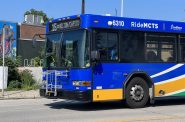 Jul 13th, 2024 by Graham Kilmer
Jul 13th, 2024 by Graham Kilmer
-
MCTS Designing New Bus Shelters
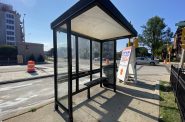 Jul 10th, 2024 by Graham Kilmer
Jul 10th, 2024 by Graham Kilmer
-
MCTS Updates RNC Bus Detours To Better Serve Downtown, Riders
 Jul 9th, 2024 by Jeramey Jannene
Jul 9th, 2024 by Jeramey Jannene

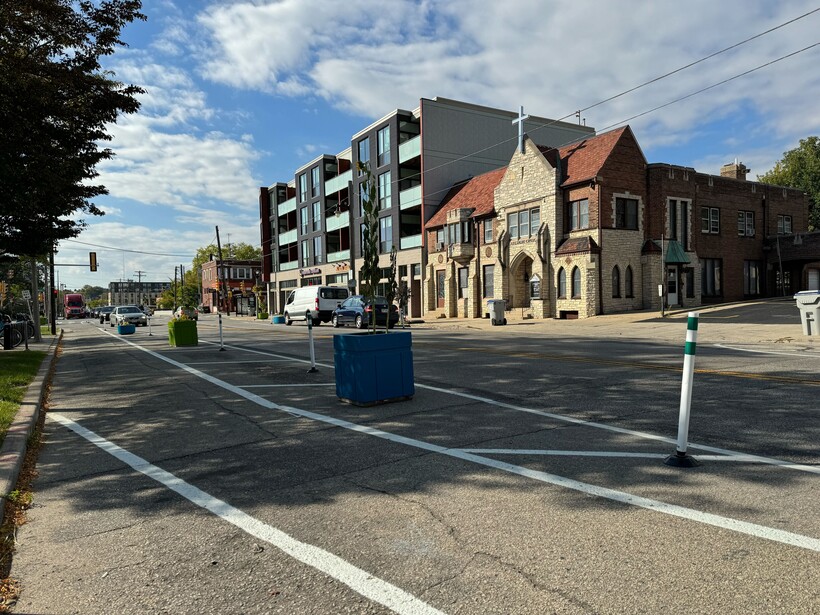
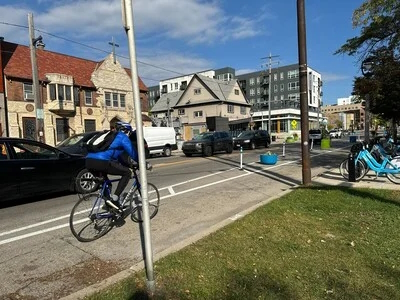
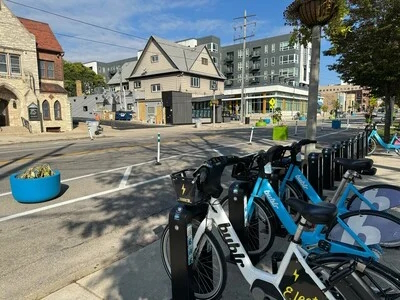


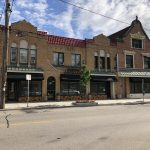

















“These crashes sometimes happen when bicyclists who are riding on the sidewalk in the opposite direction of adjacent traffic are struck by a driver turning right out of an intersecting street or driveway, but they may also be due to drivers not checking the bike lane before turning,” the analysis said.”
and yet not a word about biker education.
Besides protected lanes, efforts to slowdown drivers and decrease reckless drivingwith speed bumps and humps and more bump outs on corners and streets with high traffic volume will make the street safer for bikers and pedestrians.
In Vancouver, – a city with a grid street system much like Milwaukee – they have established Bike focused streets one block off the major thoroughfares. Rather than bike lanes on busy major streets, the next street over is designated a ‘bike street” with bikes and cars coexisting, but much less vehicle traffic.